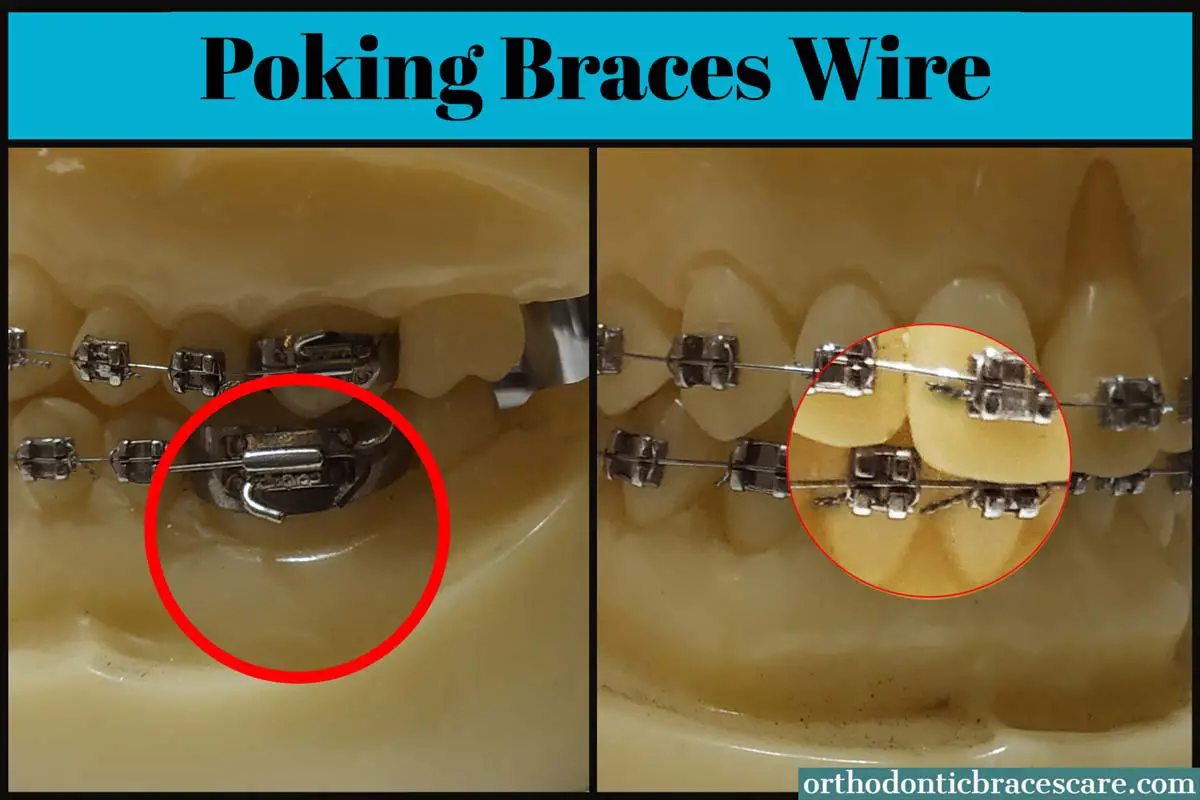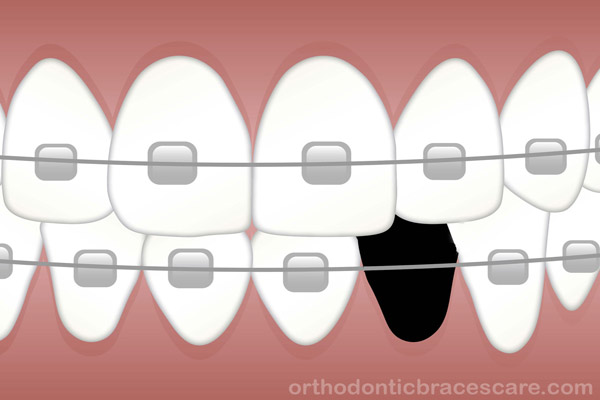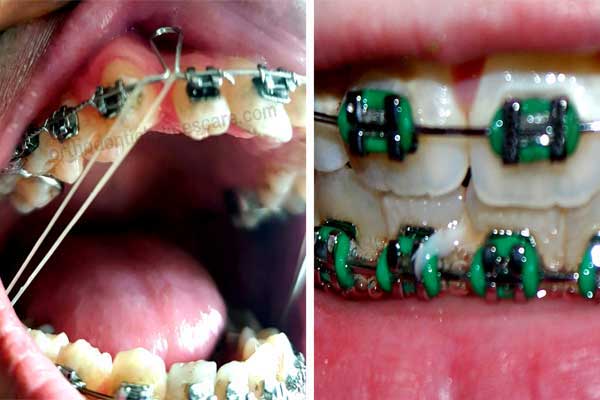Last updated on August 22nd, 2022 at 03:55 pm
Pain and discomfort are part of orthodontic treatment. Sometimes, a braces wearer has to face a problem such as braces wire poking back of the mouth.
Poking braces wire is the situation when the one end of the wire comes out of the bracket and starts hurting the cheek, gums, or back of the mouth. This may happen due to wrong food selection, poor tooth cleaning technique, any accident, or poor wire bending during tightening.
You can stop it temporarily with a simple trick at home. However, you must visit the orthodontist to fix it permanently.
If you ignore it, you’ll end up with serious problems.
A poking wire can cut your cheek or gums and make a sore or painful mouth.
Now, you may wonder how to fix braces wire from poking at home, why this happens and how can prevent it from happening next time.
We’ll discuss all of these here in this article. You’ll also know how to get rid of sores or a cut from poking braces wires at home and what to do when the wire of your braces is poking you.
What is the Poking Braces Wire?

If you are reading this article before getting braces from your curiosity, we want to tell you about the poking out braces wire first.
Your orthodontist puts brackets on your teeth with glue. Then, he or she uses an archwire to put pressure on the teeth. Each bracket contains a hook and slot.
The archwire is a curve and thin metal wire placed in the slots of brackets. It connects the all braces. It helps moves teeth and aligns your teeth perfectly.
There are other types of wires that are attached to the hook of the brackets individually. They are called ligature wires.
The orthodontist tightens them so that the archwire can be placed properly on the brackets. This helps archwire put appropriate force on your teeth through the brackets.
Now, let’s know about poking wires.
Because of certain causes, sometimes one end of the braces wire (archwire) can poke out from the back bracket.
This sharp end of metallic wire pokes your cheek. Commonly wire comes out from the bracket or band that is placed on your back tooth.
This condition is painful and irritating resulting in other problems.
Sometimes, a ligature wire can also get pokey if it gets loosened or displaced from the bracket slot.
If wire and springs on braces are confusing to you, know that they are two entirely different things.
If you want to know about that, check out my article on broken coil springs or forsus appliance.
What happens if the wire in the braces keeps poking out?
Take a look at the problems that you have to face if you have pokey wire:
1. Poking the cheek and gums
Wires are placed on your teeth facing toward the cheek. So, when the wire comes off, it’s the sharp end will poke your cheek.
2. Cutting cheek and gums
When the metal wire becomes pokey, it cuts inside your mouth and gums.
3. Sore gums and cheek
Continuous poking of the wire can lead to sore gums and cheek.
4. Ulceration
If you can’t stop a poking wire from hurting your cheek, it’ll result in ulceration and you will have a lot of trouble.
5. Stopping tooth movement
Sometimes, a poking wire can be a result of loose or popped-out wires. That means, the wire loses its functionality.
As a result, it doesn’t provide adequate pressure on the tooth and stops the movement.
6. Delaying treatment
Since the problem with braces like pokey wires can stop tooth movement, it delays orthodontic treatment, and sometimes, the outcome may not be good.
Why do you have poking braces wire?
Here are the causes of poking braces wire:
1. Long archwire
Sometimes after getting archwire, you may have an excess wire toward the back of your mouth.
It occurs when the archwire is longer than the required length. This causes a pokey wire that can hurt you.
2. Excess wires after tightening
A ligature wire may not be properly cut off when braces are tightened. That extra wire may begin to poke your gums or cheek.
3. Displaced ligature wire
Ligature wires can be displaced if you don’t take care of them properly. You might be brushing your teeth carelessly or eating the wrong food.
4. Loose wire
If you wear your brackets for an extended period of time, the wires may become loose after completing their work. It can happen when your braces are damaged as a result of chewing hard food or vigorously brushing your teeth.
5. Bent wire
Sometimes, braces wire may get bent due to damage or after wearing them for a long time. This can cause the wire to get pokey.
6. Not eating braces-friendly foods
Eating hard and crunchy foods with braces puts pressure on the teeth and braces. This weakens the wire and loosens it, which can make the wire pokey later.
7. Wrong tooth brushing method
Brushing your teeth too hard, vigorously, or in the wrong way can easily loosen your wire, which leads to poking wire.
8. Braces unfriendly toothbrush
Brushing your teeth with a stiff brush hits your wires badly. This injury easily causes the poking wire.
9. Wrong flossing technique
Flossing is one of the most important things to maintain oral hygiene while wearing braces.
However, the wrong technique of flossing can damage the wire and make it poly.
10. Playing with the wires
Many children give their hands repeatedly to the wires and play with them. This causes loosening of wire and they may end up having a poking wire gradually.
11. Bad oral habit
Biting on a nail or pen is the worst for the braces and wires. Other bad habits like tongue-thrusting also cause this problem.
12. Injury
Unfortunately, an accident can break the braces and make the wires pokey. It also causes more harm to your mouth while wearing braces.
So, you have to care more during the orthodontic treatment.
13. Experimenting with the wires
Many people think, why do they have to go to the dentist again and again? Why can’t they do that on their own?
That is why they might copy the orthodontist and try to tighten the braces at home. But, this can cause pokey wires.
Why don’t orthodontists use something that can’t be pokey?
It’s an odd question, but you might ask it if the pokey wires irritate you. Orthodontists have to use metal wires because it is the most effective way to apply pressure to your teeth in order to correct misaligned or crooked teeth.
You also get rubber bands or elastics to move teeth in certain positions during orthodontic treatment.
But, the wires are mandatory for the treatment. So, what you should think about is how to stop having pokey wire instead of questioning that.
How to fix a poking braces wire at home?
Poking braces wire is a very common problem for braces wearers, and it can happen suddenly. And, you may not make an appointment at that moment. The sharp end of the wire starts poking your cheek or gums.
So, you must want to know, “How to fix a poking wire on braces at home?”
You can fix poking braces wire using one of the following methods:
- Putting an orthodontic wax
- Pushing the wire away from the cheek with a pencil eraser, spoon, or cotton swab
- Bending the wire with tweezers or a plier
- Cutting the wire with a nail clipper or fingernail scissors
You can follow these methods if you cannot visit your orthodontist immediately. But, it doesn’t mean, you don’t need to make an appointment. Your orthodontist must fix the braces wire permanently.
Now, let’s know in detail how to handle poking wires on braces at home.
You have to use simple tools that are available at home. However, you may need it to buy some tools from nearby dental stores.
Here are some simple methods to fix a poking braces wire at home:
Method 1: Putting an orthodontic wax
The easiest solution to a poking wire is to put a piece of orthodontic wax on top of it. As a result, the sharp edge of the wire can not hurt your cheek, gums, or back of the mouth.
But, how to use the wax?
Here is the step-by-step guide to using wax on a poking braces wire:
1. Collect orthodontic wax.
Your orthodontist can provide you with dental wax. If you don’t have the wax at home, you can purchase it at a dental store. Sheets of ortho wax are available.
Check out the best orthodontic wax for braces.
2. Wash your hands properly.
Wash your hands with soap and give them a try. You must keep it inside your mouth and a dirty piece of wax is bad for your health, so don’t touch it without first cleaning your hand.
3. Take a sheet of wax.
Keep a clean wax in a clean place inside a box or packet. You must remove a small amount of wax from this sheet.
However, you cannot reuse a previously used piece of wax. Keep in mind that you must practice good oral hygiene.
4. Cut a piece of wax.
Cut a piece of wax as much as you need to cover the poking wire with your fingers.
5. Form a wax roll.
Roll it between your fingers in the palm of your hand.
6. Wash your mouth thoroughly.
Before putting wax on the wire, brush, and floss your teeth properly to remove all the food debris.
If you put wax without washing your mouth, food debris and germs get stuck between the wax and tooth.
This leads to cavity formation and sensitivity of the tooth. So, be careful.
7. Dry the affected area.
Dry the wire, brackets, and teeth after cleaning the mouth. Keep your lips and cheeks away from the area where you’ll be applying wax.
In this way, air helps dry the surface. However, you can dry it with a sterile and clean gauze piece.
However, cotton should not be used because it can become trapped in the pokey wire.
8. Use a mirror.
Apply the wax to the poking surface of the wire with your hand. You can do it by looking at the mirror.
9. Apply the wax.
Take the wax on the tip of your finger. First, put it on the sharp pokey edge of the wire. Then, gently press it until it covers the wire completely.
Make sure that it covers the poking end of the wire, as too much pressing can result in poking out wire through the wax.
It’s normal to feel a bit sore or in pain after putting the wax, as it gives pressure on the tooth and bracket.
But, it goes away over time.
10. Use the wax correctly.
Replace the wax from time to time, at least 4 to 5 times a day. Discard the wax immediately that you have already used.
To keep yourself from swallowing the wax while you eat, remove it.
Don’t worry if you accidentally swallow some wax; most of the time it won’t hurt you. But if it does, you can talk to your orthodontist.
With wax on your braces, avoid using the toothbrush or floss. Use the wax as usual until you visit your orthodontist.
But maintaining the wax in your mouth for a long time can be a hassle for you. So, make an appointment fast.
Method 2: Pushing wire away from cheek with the eraser end of a pencil
If wax for braces is ineffective for you, you may wonder, “How to fix a poking wire on braces without wax?”
If the thin wire used for tightening is sticking out of the bracket, use the eraser end of a pencil.
Due to its thickness, it’s not good for the archwire. Therefore, using this method to bend the archwire is challenging.
Moreover, you don’t have good access to the area as well because it remains in the back of the mouth.
Let’s discuss fixing thin wire now.
Following are the steps to use a pencil eraser to fix a thin wire that is poking:
1. Pick up a clean pencil with an eraser.
Make sure the pencil’s eraser end is clean. It’s better to take a new pencil for that. Before using it, you can also wash and dry the eraser end with soap.
2. Use a mirror to check the wire’s position.
Use the technique while standing in front of a mirror to ensure you don’t make any mistakes.
3. Pull your cheek with a clean hand.
Use soap to wash your hands. Hold the side of the cheek that has the issue next. Pull the cheek away to reveal the area now.
4. Touch the poking wire with the eraser end of the pencil
With your other hand still holding the pencil, touch the eraser end to the wire’s protruding end.
5. Push the wire gently away from the cheek
Put gentle pressure after touching the wire’s pointy end, then tuck it away from the cheek and toward the brackets.
Try to place the wire close to or underneath the archwire.
However, you have to do it carefully so that it can’t cause other problems. This process only works with a thin flexible wire.
Method 3: Pushing wire with cotton swabs or spoon
Follow the same procedure as you do with pencils. Speaking of sterile instruction, there is another thing like a cotton swab.
Every time you use a cotton swab for braces, use a fresh one. Because it is soft, the wire of the braces is not easily broken. It doesn’t harm you either.
You can also the back end of a spoon. Wash it with soap nicely before using it.
You have to be very careful of using a spoon, otherwise, it may hurt your teeth or braces.
Method 4: Bending the wire with tweezers
Sometimes a pencil can’t help you solve the problem of a poking wire. In that case, tweezers can be a great tool. You can grab the wire with it and move it freely.
It’s more effective to fix the archwire that gets slipped out of the back bracket. It can also be used for thin, protruded ligature wire.
Tweezers may also be employed to fix the colorful elastic bands or ligatures.
Here are the steps of using it to fix a poking braces wire:
1. Take a thin-nosed tweezer.
Braces wire is thin and flexible with a small diameter. Therefore, choose tweezers with a nose that is thin or pointed.
2. Use antiseptics to disinfect the tweezer.
Do not use a dirty tweezer. Before using it, you must sterilize it with an antiseptic.
3. Thoroughly clean your mouth.
Clean your mouth thoroughly and remove all food debris before you fix the braces wire. Otherwise, food debris might stay between the wires.
4. Make the region visible in front of a mirror.
To reveal the area where the wire needs to be fixed, pull your cheek outward. You can ask your family or friends for assistance if you are unable to complete the task on your own.
5. Using the tweezer, hold and move the poking wire.
Hold the tweezer in your dominant hand and move the cheek with your other hands. Take hold of the protruding wire’s head, then gently bend or tuck it back toward the bracket or tooth.
Try to tuck the wire’s pointed end under the bracket. Put the end of the slipped wire into the slot or tube of the back bracket if there is one.
You can use the same method to fix broken braces laces, even if it happens in front teeth.
To avoid being hurt, simply push the wire away from the lips or cheek.
Pushing the wire should be done with caution to avoid breaking the braces or cutting your cheek. However, if you believe it to be a challenging task, have it fixed by seeing your orthodontist.
Method 5: Using braces pliers to fix a poking wire
Another tool you can use is a braces plier. It appears more professional. Even though it requires skilled hands, you can ask for assistance from your family or do it yourself by staring in the mirror.
1. Purchase an orthodontic plier.
To begin with, you need to purchase an ideal-sized braces plier. However, they cost more and require more effort to use than other fixing methods.
So, tweezer can be the best option for you.
2. Make the pliers sterile.
The braces plier should be cleaned with antiseptic. Never use unsterilized tools for your braces.
3. Using the braces plier, bend the wire and tuck it behind.
Using the pliers to hold the wire’s end, slowly bend and push the wire away from the cheek. Don’t exert too much pressure or you could damage the wires or braces.
Method 6. Cutting braces wire at home
If the above methods do not work for you, you can try to cut the wire. You can just use a tool that you have at home, like a nail clipper or fingernail scissors. A dental plier that is used to cut dental wires is also available for purchase.
However, you should first try using a nail clipper because the orthodontic wire is thin and flexible, making it simple to cut with one.
Wait until your next appointment with your orthodontist and don’t cut the wire if you aren’t experiencing any serious issues.
Even if you do, be careful that you don’t break the braces or wire and make the situation worse.
Check out how to cut braces wire at home.
How to get rid of cuts or pain from a poking braces wire?
Here are the ways to get rid of the sore cheek or heal the cuts from poking braces wire:
1. Use a mouthwash.
Purchase mouthwash, then rinse your mouth with it to treat any cuts or sores left behind by the poking wire.
2. Rinse your mouth with warm water and salt.
If you don’t have mouthwash, add a teaspoon of salt to a cup of lukewarm water.
Use it to rinse your mouth for 60 seconds. Apply it four to five times per day to relieve pain or heal cuts.
3. Avoid foods that are hard, crunchy, or spicy.
Food that is crunchy and hard to chew makes the wire more pokey or loose. Moreover, it touches the cut area of the cheek and causes pain.
Spicy foods also hurt the area. So, avoid these foods.
4. Avoid acidic foods and drink.
Acidic food and drink cause a burning sensation in the cut area. Avoid drinks like fruit juice, soda, soft drinks, hard drinks, or sports drinks.
5. Take ice cream or cold water.
You can take ice cream or drink cold water to ease pain and discomfort if you are sore or in pain. Additionally, you can such an ice cube without placing it in your teeth.
6. Use an oral numbing gel.
Apply oral anesthetic gel to the cut area if the pain becomes too intense. But before using it, get your orthodontist’s approval.
How to prevent braces wire poking out from the brackets?
Here are the ways to prevent braces wire poking back check or gums:
1. Check yourself during the appointment
You must check your braces when you visit your orthodontist for tightening or adjustment. Inform your orthodontist if you suspect an excess wire. It will be reshaped by him or her.
2. Stop playing or experimenting with the wires
Avoid playing with the wire or touching it repeatedly. You shouldn’t do anything that could damage your wire.
3. Stay away from bad habits
Ignore any habit like biting nails or pencil that could harm your wire.
4. Avoid hard, crunchy, and sticky foods
Keep an eye on your diet. Consume soft and nonsticky foods. Make no mistake about it. Do not bite into hard or crunchy foods.
5. Eat soft and braces-friendly foods
You should change your food habit. Eat soft and easy-to-eat foods while wearing braces to prevent any damage.
Know how to eat with braces.
6. Learn the toothbrushing method with braces
Following the correct toothbrushing technique for braces is essential to prevent a pokey wire. You need to brush your teeth with gentle pressure.
7. Buy a toothbrush with soft brittle
Use a soft-bristled toothbrush so that it can’t hurt the wires.
8. Follow the flossing method for braces
Learn the perfect flossing technique while wearing braces. Remember that proper flossing is one of the best ways to maintain oral hygiene, whereas poor technique can cause damage.
9. Wear a mouthguard while wearing braces and wires
When participating in an outdoor game or any activity that may involve a risk of falling, wear a mouthguard to protect your braces and teeth.
Is a poking braces wire an emergency?
Poking braces wire isn’t an emergency. So, you don’t have to go to the orthodontist immediately for this. However, you must consult your orthodontist as soon as possible to make an appointment to fix the problem permanently. In meantime, you need to manage it at home so that the wire can’t hurt your gums or cheek.
Otherwise, it can cause other complications and stop the progress of treatment.
But, if the pokey wire cuts your cheek too deeply and you are unable to stop the bleeding, contact your orthodontist and follow his or her instructions.
This type of issue, however, is uncommon with braces.
Takeaways
Poking braces wire can be a result of a long archwire, imperfect braces adjustment, biting on hard foods, or cleaning the tooth carelessly.
If you don’t solve the problem, you may end up with a cut or ulceration on the cheek and gums. However, you can stop the braces wire poking back of the mouth at your home.
Poking braces wire can be fixed using orthodontic wax, pushing it away from the cheek with a pencil eraser or cotton swabs, and cutting it with a nail clipper or dental wire cutter
Though you can fix a poking braces wire at home, it’s not the permanent solution.
You should make an appointment as soon as possible to prevent any further issues like an error in tooth movement.

Dr. Pallab Kishore, MS in Orthodontics and owner of Orthodontic Braces Care, shares expert tips on braces, aligners, and oral health from 10+ years of experience.


